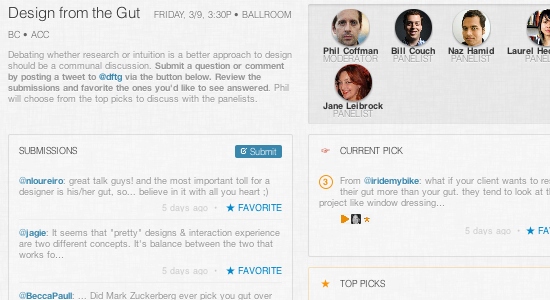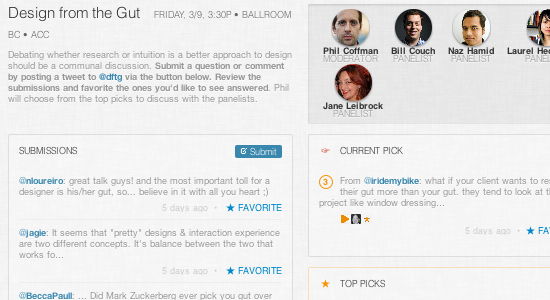William Couch, a Twitter developer and software engineer, built Osprey a tool to manage Twitter as a backchannel during events. Here is why it matters.
Mashable reports that during SXSW, William Couch demoed Osprey a new Twitter backchannel platform for events.
It happened during the Design from the Gut panel at SXSW.
You can see it in action here.
Why I like it
For those approaching live tweeting at events for the first time, you may ignore the fact that there are tons of tools to visualize Twitter at events. Osprey is a rather simple one when compared to other solutions such as Twubs.
Its simplicity though it what makes it special.
Users are not asked to tweet hashtags, thus filling their followers’ stream with what I call twomiting.
Attendees can send an @reply to the event account. Users can favorite tweets determining the most favourite interactions/discussion.
The brilliance of the tool is in the reasoning behind it:
[…]if we used the existing mechanisms of Twitter, retweets and hashtags would be the customary signals available for us to monitor through the API. I didn’t want to use those though, and impose our discussion onto those not at the event — often times, the internet needs to be quieter.
There are other mechanisms available through Twitter we could use, but we’d have to build something on top of the service to fully utilize them. My two favorite signal mechanisms are replies and favorites, because they are inherently quiet. Replies are scoped to only those who follow both accounts, and favorites are nearly silent — but we can monitor both through the API, with a little work. This is how Osprey was born.
I can only say bravo! This is exactly the pain we all feel when we don’t attend events but our followers do. I guess that technically William has introduced the concept of Like or Digg to Twitter.
Why Should You Care?
Ospray is a great answer to a common Twitter issue. The fact that it comes from a Twitter engineer, well, makes it even more special.
Hashtags were a suggestion of a Twitter user (Chris Messina). They became very popular mostly because there was no real alternative to categorize tweets (or groups at the time). I am not the only one to say that Twitter is ready to show us more comprehensive ways to digest live tweeting.
Despite the recent introduction of the hashtag button, I feel the picture is not complete and needs more effort.
In Conclusion
Probably Ospray won’t be the final version of an official Twitter backchannel solution for events but it looks like a good attempt.
Keep an eye on William’s blog for a possible release.






